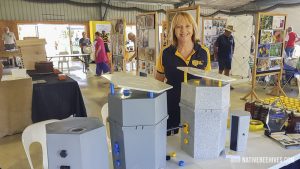Australian Native Bee Association – Honey Standards Meeting 04/08/2019
In October 2018 a number of people involved with the Stingless Bee industry came together to discuss the future of the industry and a possible need for some kind of guideline or preferred standard for the honey produced and sold. A common Stingless Bee colony may only produce up to 1kg of honey per year and it’s also difficult to harvest so the product can be quite expensive, up to $200 per kilo.
A committee was created and a lot of work has gone on behind the scenes since, with the forming of the Australian Native Bee Association. It was important to create an Association so a honey standard could be investigated and hopefully come to some kind of agreement of what that standard might be. The honey standard would be one small part of what the Association could do for the industry.
Dean Haley and Tim Heard presented some information at the Brisbane Branch of the Association August meeting to keep members up to date with the progress. It was also a bit of a Stingless bee educational workshop with some great information about bees and honey. I took some basic notes….
Bee Biology
Tim started out describing the two types of stingless bee we have in Australia and how they make honey. Most people will have Tetragonula Carbonaria or Tetragonula Hockingsi in their backyard hives. Another less common species to have is Austroplebia.

Moisture Content
Plant nectar can contain 80 to 90% water and the term “Ripening Honey” describes the process of the bees reducing the amount of moisture in the nectar. The nectar can be placed in to a collective pool of nectar within the hive and the bees will fan their wings to reduce the moisture content and also use “Bubbling”, which is passing nectar in and out of the mouth to reduce the moisture content. Bees also add enzymes to the honey to chemically alter the sugars in the nectar to create honey.
European Honey Bee Honey has a maximum industry standard moisture content of 21%, Stingless Bee (Tetragonula) honey has a moisture content of around 26%, and Australis Stingless Bee Honey also has a moisture content of around 21%.

Equilibrium Moisture Content
Trevor Weatherhead brought up the subject of Equilibrium Moisture Content. Honey is Hydroscopic, so it can lose moisture to the air and it can also absorb moisture from the air.
Antimicrobial
European Honey Bees use nectar from one particular plant to make Manuka which is rich in antimicrobial activity, where Stingless bees make antimicrobial honey from any plant and it has even more antimicrobial activity than European Honey Bee Honey.

Honey Bees create wax structures to store their honey in (honeycomb), so honey is not affected by the wax as it’s classed as being chemically stable.

Stingless Bees store their honey in structures made from Propolis, a mixture of plant resins which does have an effect on the honey. The honey could also possibly ferment within the honey pot.
Australis Stingless Bees create their honey pots from mostly wax so the honey wont be affected.
Microbiology
Dean talked about microbiology and how micro organisms are the same for honey bees and stingless bees. Not all organisms found in honey come from the gut, some microbes are in the hind (the “bee hind”? 🙂 and some are transferred to the inside of the Stingless Bee honey pot from dirty bee feet!


Mites
Dean also mentioned how it’s completely normal to find Mites in a hive and you might find a dozen species in one hive. Mites live inside hives cleaning up and eating bee poo/waste.
Preserving Honey & Fermentation


There’s a few methods for preserving stingless bee honey including reducing the moisture content or refrigeration.
Stingless Bee honey will naturally ferment if left at room temperature. Dean Haley has done some testing over time on this and is quite happy with the fermented honey.
Stingless Bee Honey Product
The Australian Native Bee Association is forming a subcommittee to look at how it can develop a standard for Stingless Bee Honey and ways to give the public confidence in the product they’re buying.
It’s very difficult and maybe impossible to actually test any kind of honey accurately, including European Honey Bee Honey, so we just have to trust that people will produce a quality product.
The Association might prefer some guidelines are followed when producing the product and give approval of the product though it probably wont be the job of the Association to police any standards, all it can do is encourage good practices.











